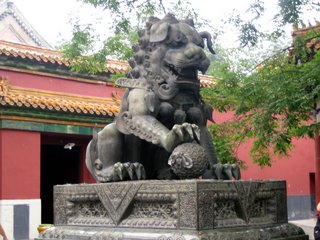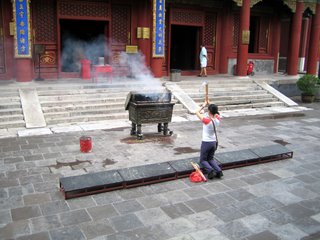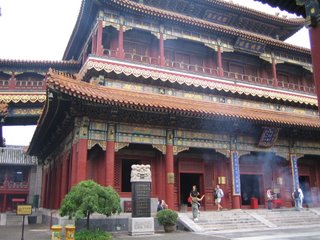The Lama Temple

Yonghe Gong (The Lama Temple), built in 1694, is Beijing's largest and best known Buddhist lamasery. The Lama Temple is part of the Gelukpa ("Yellow Hat") Sect of Tibetan Buddhism, and was only able to survive China's Cultural Revolution through the protection of Chinese President Zhou
 Enlai. The temple did well in pre-Community Beijing in part because the Manchu Qing emperors, though officially Confucians, were attracted to Lamanistic Buddhism. This is particularly interesting given the current political situation between China and Tibet.... but as usual, I'll try to steer clear of overt political commentary on this blog.
Enlai. The temple did well in pre-Community Beijing in part because the Manchu Qing emperors, though officially Confucians, were attracted to Lamanistic Buddhism. This is particularly interesting given the current political situation between China and Tibet.... but as usual, I'll try to steer clear of overt political commentary on this blog.According to this website, among the characteristic features of Tibetan Buddhism are its ready acceptance of the Buddhist Tantras as an integral and culminating part of the Buddhist way; its emphasis on the importance of the master - disciple relationship for both religious scholarship and meditation; its recognition of a huge pantheon of Buddhas, bodhisattvas, saints, demons, and deities; its sectarianism, which resulted less from religious disputes than from the great secular powers of the rival monastic organizations; and, finally, the marked piety of both monastic and lay Tibetan Buddhists, which receives expression in their spinning of prayer wheels, their pilgrimages to and
 circumambulation of holy sites, prostrations and offerings, recitation of texts, and chanting of Mantras, especially the famous invocation to Avalokitesvara Om Mani Padme Hum, which I might have heard some people chanting while I was at the temple yesterday.
circumambulation of holy sites, prostrations and offerings, recitation of texts, and chanting of Mantras, especially the famous invocation to Avalokitesvara Om Mani Padme Hum, which I might have heard some people chanting while I was at the temple yesterday.The main buildings of the Yonghe Gong are built along a central axis, proceeding from the Yonghe Gate Hall, through the Yonghe Gong Hall, Yongyou Hall, Falun Hall, and Wanfu Ge Hall, ending up with the Suicheng Lou Hall, which is home to a 20 foot statue of Tsongkhapa, the founder of the Gelukpa Sect. The area was simply lovely -- all photos were taken only outside, because photographs are forbidden inside the places of worship themselves -- and very peaceful, too. Amid the throngs of tourists wandering quietly through the temple were people who had actually come to worship: kow-towing before the giant Buddha statues (which, unlike the idols worshipped in some religions, are merely viewed as seats of divinity rather than divine in and of themselves), holding their sticks of incen
 se high over their heads and prostrating themselves before the great religous symbols before us.
se high over their heads and prostrating themselves before the great religous symbols before us.While the most dedicated Tibetan Buddhists (i.e., monks) seek nirvana, for the comThere are a number of Buddhist statues in every hall, which one of the other students, a Religion major back home in the states, was able to tell us a lot about. She informed us thatmon people, the religion often still retains shamanistic elements. Worship includes reciting prayers and intoning hymns, often to the sound of great horns and drums (though none of this was heard at the Lama Temple). A large pantheon of spirits, ghouls, and genii are often portrayed being crushed by Buddhas and bodhisattvas (future Buddhas) in sculpture, which we saw but I was of course unable to photograph. The monastic orders of this sect of Buddhism apparently include abbots, ordained religious mendicants, novices (candidates), and neophytes (children on probation). We caught sight of a monk near the last temple (see picture) and Kevin told me the story of why many Buddhist monks in China wear a garment which only covers one
 arm, and why they use only one hand (rather than two, clasped in a prayer-like position) in making a bow.
arm, and why they use only one hand (rather than two, clasped in a prayer-like position) in making a bow.The legend is this: many many years ago in ancient China, a young Buddhist worshipper named Shenguang desperately wanted to speak with Bodhidharma, the founder of the Chan sect of Buddhism in China (whose practices are known as Zen Buddhism in Japan), to join the master's monastery and spend the rest of his life seeking enlightenment. This website tells the story thus:
"Shenguang pursued Bodhidharma all the way to Xiong Er Shan( Bear's Ear Mountain), which was in the Song range, the middle range of the five great mountain ranges of China. Bodhidharma was sitting there facing a wall, not speaking to anyone. Shenguang tried to talk to Bodhidharma, but the Patriarch completely ignored him.
 And so Shenguang knelt there. He knelt for nine years while Bodhidharma sat. After nine years of kneeling his skill was fairly well developed, but it had not yet been brought to realization.
And so Shenguang knelt there. He knelt for nine years while Bodhidharma sat. After nine years of kneeling his skill was fairly well developed, but it had not yet been brought to realization. In the winter of the ninth year of kneeling, there was a great snowfall. The snow covered him as he knelt there. It reached clear up to his waist. Probably he was shaking with cold and decided to try to speak to the Patriarch again.
'Patriarch, please be compassionate and transmit the Dharma to me. I realize now that you have Way virtue, that you are One Who Has Obtained the Way.'
Bodhidharma asked him, 'What is falling outside?'
'Snow.'
'What color is the snow?'
'Snow is white.'
'When the snow turns red, I will transmit the Dharma to you.' This was a test. But by that
 time Shenguang could figure out what to do.
time Shenguang could figure out what to do.'Fine,' he thought, 'You want red snow?' And so he took his precept-knife, which was carried by the ancients. It was to use if a situation ever arose in which one would have to break a precept. Rather than break a precept, one would prefer to use the knife to cut off one's own head. But now Shenguang grabbed the knife and sliced off one of his arms. The blood spurted out all over the place and colored the snow red. He took up a bunch of the red snow and went before Bodhidharma, holding it aloft to offer to him. 'See, the snow is red,' he said.
Bodhidharma was impressed by Shenguang's devotion to his study and accepted him as his student, making h
 im the Second Patriarch. And so the First Patriarch and the Second Patriarch continued the Buddha's teaching down through the ages."
im the Second Patriarch. And so the First Patriarch and the Second Patriarch continued the Buddha's teaching down through the ages."Now, not all Buddhist monks follow the practice of using a one-handed greeting and a one-armed robe -- typically only Shaolin monks do it this way, and I am not sure of the relation between Shaolin and Tibetan monastic practices, but the monk we saw (see picture) was certainly wearing Shaolin-looking dress. The atmosphere of the whole place was somehow holy, the air filled with incense and the silent prayers of the worshipers bowing before the great serene likenesses of their leader.


<< Home